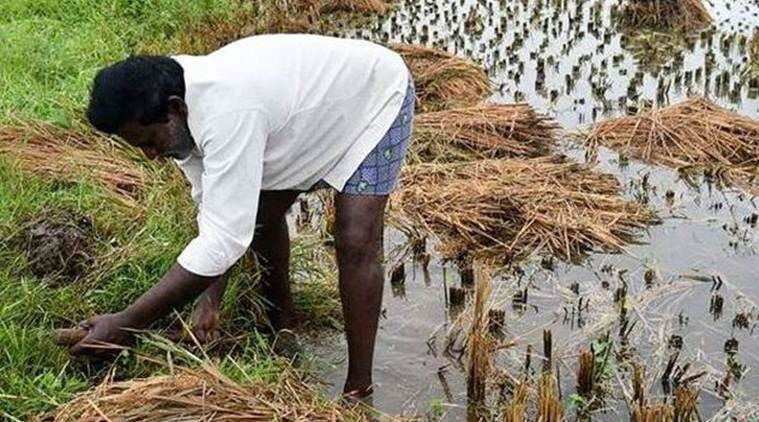
Heavy rainfall and strong winds triggered by Cyclone Montha have devastated agricultural communities across Bihar, leaving thousands of farmers in severe financial distress. The cyclone has caused catastrophic damage to harvested and standing crops, particularly paddy fields that were ready for harvest, forcing farmers to confront potential economic ruin after months of investment and hard labor.
Widespread Crop Destruction Across Districts
The crisis has intensified across multiple districts in Bihar, with Cyclone Montha bringing extremely heavy rainfall since late October 2025. The India Meteorological Department issued orange alerts for seven districts—East Champaran, Shivhar, Sitamarhi, Madhubani, Supaul, Araria, and Kishanganj—warning of extremely heavy rainfall and thunderstorms. Additionally, yellow alerts were issued for 22 other districts including West Champaran, Gopalganj, Siwan, Saran, Vaishali, Samastipur, Muzaffarpur, Darbhanga, Madhepura, and Saharsa.
In the Hilsa region of Bihar Sharif, continuous heavy rainfall accompanied by strong winds has caused ripe paddy crops to collapse directly in farmers’ fields. Thousands of acres of mature paddy have fallen over, rendering harvesting nearly impossible as the grains have begun to rot. Farmers reported that despite expecting good yields this season to recover from previous flooding losses, the persistent rainfall has destroyed months of agricultural effort.
Financial Devastation and Delayed Sowing
The problems extend beyond immediate crop damage. Heavy rains have waterlogged fields intended for Rabi season crops, including mustard, potato, and maize. The delayed sowing of these crops—currently at only around 25% completion—threatens to compound farmers’ losses further. Additionally, the persistent moisture and high humidity levels have discouraged farmers from harvesting remaining crops, as they fear additional spoilage before threshing can be completed.
Farmers across the state who had invested significant capital through agricultural loans now face the prospect of unable to repay these debts. Many laborers depend on harvest season for income, and the delayed or impossible harvesting has left them without employment opportunities.
Agricultural Department Response and Assessment
Recognizing the scale of the disaster, agricultural officers have been deployed to assess crop damage across affected areas. The district agriculture departments have initiated comprehensive surveys at the block and village levels to quantify losses and prepare compensation recommendations. However, the ongoing rainfall has hampered damage assessment efforts, with officials waiting for weather conditions to improve before completing field inspections.
The Bihar government is expected to provide relief assistance to affected farmers, including compensation for damaged crops and potentially free seeds for replanting alternative crops during the subsequent planting season. Nevertheless, farmers have expressed frustration that compensation processes are often delayed, leaving them in financial hardship during the critical post-harvest period.
Regional Variations in Impact
While northern districts have borne the brunt of Cyclone Montha’s impact, other regions including Prayagraj have also experienced significant agricultural losses. In Prayagraj’s Meja region, farmers reported that harvested paddy bundles were scattered by strong winds, and fields were completely submerged. The flat terrain of many paddy-growing regions exacerbates waterlogging problems, as drainage becomes nearly impossible during intense rainfall events.
Broader Agricultural Challenges
This crisis comes as Bihar’s agricultural sector faces mounting pressure from multiple environmental stressors. Earlier in 2025, the state experienced severe monsoon rainfall deficits of up to 70% in districts like Sitamarhi and Saharsa, forcing farmers to spend considerable resources on irrigation. Now, the opposite extreme—excessive unseasonal rainfall at harvest time—threatens to undo any recovery gains.
Farmer Concerns and Government Action
Farmers have emphasized that despite their hard work and substantial capital investment in cultivation, extreme weather events at critical agricultural periods continue to undermine their livelihoods. The combination of drought conditions during planting season and excessive rainfall during harvest season creates an impossible agricultural environment for small and marginal farmers with limited financial reserves.
Wind speeds reached up to 40 kilometers per hour during the cyclone’s peak impact, with lightning and thunderstorms adding to the hazards. Authorities have urged farmers to create drainage channels to discharge water from cultivable land and to avoid working outdoors during dangerous weather conditions.
As Bihar continues to grapple with the aftermath of Cyclone Montha, the focus remains on rapid damage assessment and timely compensation delivery to prevent farmer distress from escalating into a broader agrarian crisis. The cyclone’s impact underscores the vulnerability of Bihar’s agricultural economy to extreme weather events and the urgent need for improved agricultural risk management systems.


